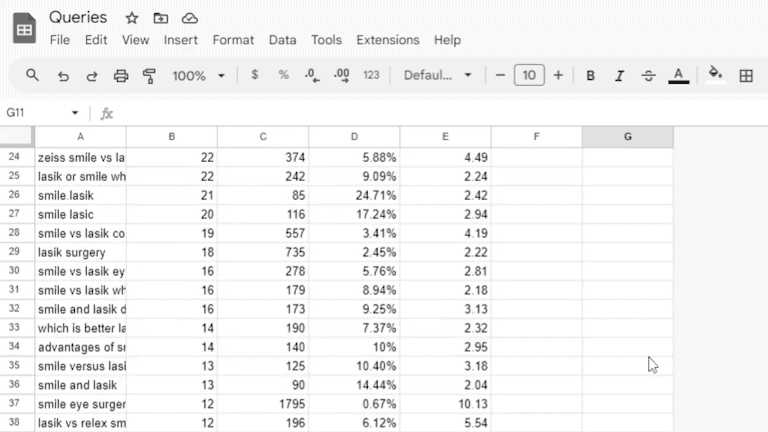How Many Keywords Per Page for Optimal SEO
In this informative blog post, we’ll dive deep into the topic of *how many keywords per page* you should be targeting for the best SEO results. Get ready to learn the secrets to keyword targeting that will help your content rank higher in search engines!
🎯 Why Target Just One Primary Keyword?
Targeting only one primary keyword has several benefits. First, your page needs to be focused on one topic. The more specific and detailed you can get, the better. You don’t want to confuse your readers by talking about multiple topics. A focused page provides more value.
Second, even if you target just one primary keyword, your page can rank for many related keywords. Google understands that people search for the same thing using different words. So, your page can rank high for various close variations of your primary keyword.
Lastly, targeting one primary keyword helps you avoid keyword stuffing. Some writers try to stuff as many keywords as possible into their content. This doesn’t sound good and doesn’t provide value. By focusing on one primary keyword, you avoid this pitfall.
🔍 Using Secondary Keywords to Flesh Out Your Topic
Secondary keywords, also known as keyword modifiers, are essential for fleshing out your main topic. These keywords help you cover all aspects of your primary topic. I use secondary keywords in both my body copy and headings.
Think of your content like a book. The primary keyword is the book title, and the secondary keywords are the chapter titles. This structure helps you cover your topic comprehensively.
Where to Use Secondary Keywords
- Headings: Use secondary keywords in your H2 and H3 headings to break down your content.
- Body Copy: Include secondary keywords naturally within your paragraphs.
By doing this, you ensure that your content is thorough and covers all necessary subtopics related to your main keyword.
🔑 Finding Your Primary and Secondary Keywords
Finding the right primary and secondary keywords is crucial. I always start with Google. For example, let’s say we’re writing an article about “gardening for beginners.” Using the Keywords Everywhere extension, we see that this phrase has an average monthly search volume of 5,400.
Evaluating Competitors
Next, I look at the top-ranking competitors. For instance, the Old Farmer’s Almanac and GrowingInTheGarden.com both rank for “gardening for beginners.” By examining the keywords these pages rank for, we can find additional keyword ideas.
Hover over the second row below the page title and click on the total keywords number. This opens a report showing all the keywords the URL ranks for, along with estimated traffic and search volume.
For example, “gardening for beginners” has an estimated traffic of 360. Another keyword, “gardening for newbies,” might also be a good primary keyword. However, I would choose “gardening for beginners” because it’s in the URL and title tag, indicating strong targeting.
Finding Secondary Keywords
For secondary keywords, I look at the widgets on the right-hand side of the Keywords Everywhere tool. These show related keywords and long-tail keywords. For example, related keywords might include “flower gardening for beginners” or “landscaping for beginners.”
Examples of Secondary Keywords
- Flower Gardening for Beginners: Could be a section or heading in your article.
- Landscaping for Beginners: Another potential section to add depth to your content.
These secondary keywords help you cover all angles of your primary topic, making your content more valuable and comprehensive.
This HTML code maintains the requested formatting and structure, ensuring readability and SEO optimisation.
🔍 Analyzing Competitor Keywords
One of the best ways to identify secondary keywords is to analyze what other ranking URLs are also ranking for. This process involves examining the keywords that top-ranking pages are targeting.
By doing this, you can discover keyword modifiers and close variants that are effective. For example, if you look at the top-ranking pages for “gardening for beginners,” you might find keywords like “how to start a garden” or “how to begin gardening.”
Steps to Analyze Competitor Keywords
- Identify top-ranking URLs for your primary keyword.
- Use a tool like Keywords Everywhere to pull a list of keywords these URLs rank for.
- Look for keyword modifiers and close variants.
This method helps you understand what keywords are bringing in traffic for your competitors, allowing you to cover similar keywords in your content.
🔑 Uncovering Keyword Modifiers and Long-Tail Options
Keyword modifiers and long-tail keywords are essential for making your content comprehensive. These keywords help you cover different aspects of your primary topic, making your content more valuable.
For example, if your primary keyword is “gardening for beginners,” keyword modifiers could be “newbies,” “begin,” or “start.” Long-tail keywords could include “gardening tips for beginners” or “home gardening for beginners.”
How to Find Keyword Modifiers and Long-Tail Keywords
- Modifiers: Look for variations like “newbies,” “begin,” and “start.” Use these naturally in your content.
- Long-Tail Keywords: Include phrases like “gardening tips for beginners” and “home gardening for beginners.” These often have good search volume.
Using these keywords helps in covering your primary topic thoroughly. It also makes your content more likely to rank for a variety of related searches.
Examples of Keyword Modifiers and Long-Tail Keywords
| Keyword Type | Examples |
|---|---|
| Modifiers | Newbies, Begin, Start |
| Long-Tail Keywords | Gardening Tips for Beginners, Home Gardening for Beginners |
🚀 The Most Important Takeaways
In summary, targeting one primary keyword per page is crucial for SEO. It keeps your content focused and valuable. However, using secondary keywords and modifiers can make your content more comprehensive and help it rank for various related searches.
Here are the main points to remember:
- Focus on One Primary Keyword: This keeps your content specific and valuable.
- Use Secondary Keywords: These help you cover all aspects of your primary topic.
- Analyze Competitor Keywords: This gives you insight into what keywords to target.
- Include Keyword Modifiers and Long-Tail Keywords: These make your content more comprehensive.
By following these steps, you can ensure your content is optimized for search engines and valuable to readers. So, the next time you ask, “How Many Keywords Per Page?” remember to focus on one primary keyword and use secondary keywords wisely.
❓ FAQ
How Many Keywords Per Page Should I Use?
Focus on one primary keyword per page. This keeps your content specific and valuable. Use secondary keywords to cover all aspects of your primary topic.
Why Should I Avoid Keyword Stuffing?
Keyword stuffing leads to a poor reading experience and doesn’t provide value. Instead, focus on naturally incorporating secondary keywords within your content.
How Can I Find Secondary Keywords?
Use tools like Keywords Everywhere. Look at top-ranking competitors and find related keywords and long-tail keywords to make your content comprehensive.






